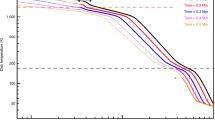Abstract
The basic stages of the formation of the planets are considered. Decay of turbulence in the solar nebula allows the precipitation of dust particles to the solar nebula's equatorial plane, their growth occurring by sticking at collisions and transformation into kilometer-sized bodies (planetesimals) partly by direct growth and partly via gravitational instability in a dense dust layer formed near the central plane of the nebula. Analytical study of the dynamical evolution of a rotating swarm of bodies with quasi-equilibrium values of velocity and mass distributions gave a reasonable description of the final stage of accumulation. This is a robust result in that the time scale of formation of the terrestrial planets is 108 yr. Numerical simulation of the earlier stage revealed an accelerated (runaway) growth of the largest bodies—planet embryos. More careful study of the intermediate stage is needed. The two-step formation of giant planets is considered: accumulation of icy-rock cores of about 10–15 Earth masses, similar to that in the terrestrial zone, and accretion of gas onto cores of Jupiter and Saturn require time scales not much longer than 107 yr (mostly for the growth of their cores). Problems connected with a slow time of growth of Uranus and Neptune are discussed. Small bodies of the Solar System are byproducts of the formation of the planets. The fall of large bodies onto the planets at the last stage of accumulation brought much of stochastics into the process (planetary obliquities, etc.). It led to a much higher initial temperature of the Earth's mantle, early beginning of partial melting and differentiation, which determined its pre-geological evolution.
Similar content being viewed by others
References
Beckwith, S.V.W., Sargent, A.I., Chini, R.S. and Güsten, R.: 1990,Astronomical Journal 99 (N3, 924–945.
Cameron, A.G.W.: 1979,The Moon and the Planets 21, 178- 183.
Fesenkov, V.G.: 1951,Astronomicheskij Zhurnal 28 (N3, 492–517 (Russ.).
Greenberg, R., Wacker, J., Hartman, W. and Chapman, C.: 1978,Icarus 35, 1–26.
Kaula, W.M.: 1980, in :The Continental Crust and Its Mineral Deposits, New York, 25–31.
Kuiper, G.P.: 1951, in: J.A. Hynek, ed(s).,Astrophysics, New York, Chap.8, 357.
Levin, B.Yu.: 1964,Origin of the Earth and Planets, 4th edition, Nauka, Moscow, Russia.
Lissauer, J.J. and Safronov, V.S.: 1991,Icarus 93, 288–297.
Lissauer, J.J., Pollack, J.B., Wetherill, G.W. and Stevenson, D.J.: 1993, inNeptune and Triton, University of Arizona Press, Tucson, Arizona, in press.
Lissauer, J.J. and Stewart, G.R.: 1993, in: E.H. Levy and J. Lunine, ed(s).,Protostars and Planets III, University of Arizona Press, Tucson, Arizona, in press.
Pechernikova, G.V.: 1991,Fizika Zemli N8, 59–72 (Russ.).
Safronov, V.S.: 1959,Fizika Zemli N1, 139–143 (Russ.).
Safronov, V.S.: 1960,Annals of Astrophysics 23, 979–982.
Safronov, V.S.: 1962,Doklady Akademii Nauk SSSR,147(N1, 64–67 (Russ.).
Safronov, V.S.: 1969,Evolution of Protoplanetary Cloud and the Origin of the Earth and Planets, Moscow, Nauka, Russia, English translation, NASA TTF- 667, 1972.
Safronov, V.S.: 1982,Fizika Zemli N6, 5–24 (Russ.).
Safronov, V.S.: 1991,Icarus 94, 260–271.
Safronov, V.S. and Ruskol, E.L.: 1957,Voprosy Kosmogonii 5, 22–46 (Russ.).
Safronov, V.S. and Ruskol, E.L.: 1982,Icarus 49, 284–296.
Schmidt, O.Yu.: 1944,Doklady Akademii Nauk SSSR 45 (N6, 245–249 (Russ.).
Schmidt, O.Yu.: 1957,Four Lectures on the Origin of the Earth, 3rd Edition, Moscow, Nauka, Russia, English translation 1959, Lawrence and Wishart, London.
Vityazev, A.V., Pechernikova, G.V. and Safronov, V.S.: 1990,Planets of Terrestrial Group. The Origin and Early Evolution, Nauka, Moscow.
Weidenschilling, S.J.: 1984,Icarus 60, 553–567.
Weidenschilling, S.J. and Cuzzi, J.N.: 1993, in: E.H. Levy and J. Lunine, ed(s).,Protostars and Planets III, University of Arizona Press, Tucson, Arizona, in press.
Wetherill, G.W.: 1990,Annual Review Earth Planetary Sciences 18, 205–256.
Author information
Authors and Affiliations
Rights and permissions
About this article
Cite this article
Safronov, V.S., Ruskol, E.L. Formation and evolution of planets. Astrophys Space Sci 212, 13–22 (1994). https://doi.org/10.1007/BF00984504
Issue Date:
DOI: https://doi.org/10.1007/BF00984504




